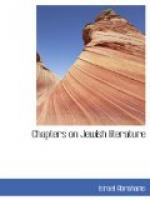A younger contemporary of Abarbanel was also an apostle of the same view. This was Elias Levita (1469-1549). He was a Grammarian, or Massorite, i.e. a student of the tradition (Massorah) as to the Hebrew text of the Bible, and he was an energetic teacher of Christians. In the sixteenth century the study of Hebrew made much progress in Europe, but the Jews themselves were only indirectly associated with this advance. Despite Abarbanel, Jewish commentaries remained either homiletic or mystical, or, like the popular works of Moses Alshech, were more or less Midrashic in style. But the Bible was a real delight to the Jews, and it is natural that such books were often compiled for the masses. Mention must be made of the Zeena u-Reena ("Go forth and see"), a work written at the beginning of the eighteenth century in Jewish-German for the use of women, a work which is still beloved of the Jewess. But the seeds sown by Abarbanel and others of his school eventually produced an abundant harvest. Mendelssohn’s German edition of the Pentateuch with the Hebrew Commentary (Biur) was the turning-point in the march towards the modern exposition of the Bible, which had been inaugurated by the statesman-scholar of Spain.
BIBLIOGRAPHY
ABARBANEL.
Graetz.—IV, II.
I.S. Meisels.—Don Isaac Abarbanel, J.Q.R., II, p. 37.
S. Schechter.—Studies in Judaism, p. 173 [211].
F.D. Mocatta.—The Jews of Spain
and Portugal and the Inquisition
(London, 1877).
Schiller-Szinessy.—Encycl. Brit., Vol. I, p. 52.
EXEGESIS 16th-18th CENTURIES.
Steinschneider.—Jewish Literature, p. 232 seq.
BIUR.
Specimen of the Biur, translated by A. Benisch
(Miscellany
of the Society of Hebrew Literature,
Vol. I).
CHAPTER XXIII
THE SHULCHAN ARUCH
Asheri’s Arba
Turim.—Chiddushim and Teshuboth.—Solomon
ben
Adereth.—Meir
of Rothenburg.—Sheshet and Duran.—Moses
and
Judah Minz.—Jacob
Weil, Israel Isserlein, Maharil.—David Abi
Zimra.—Joseph
Karo.—Jair Bacharach.—Chacham
Zevi.—Jacob
Emden.—Ezekiel
Landau.
The religious literature of the Jews, so far as practical life was concerned, culminated in the publication of the “Table Prepared” (Shulchan Aruch), in 1565. The first book of its kind compiled after the invention of printing, the Shulchan Aruch obtained a popularity denied to all previous works designed to present a digest of Jewish ethics and ritual observances. It in no sense superseded the “Strong Hand” of Maimonides, but it was so much more practical in its scope, so much clearer as a work of general reference, so much fuller of Minhag, or established custom,




